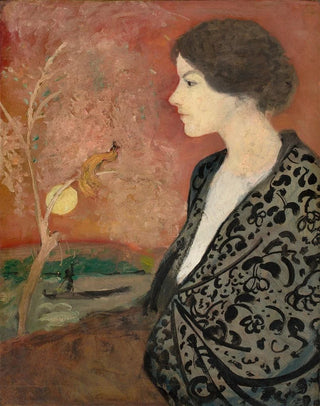Painting Study of Elisabeth Gerhardt - August Macke | Art print


View from behind

Frame (optional)
In the vibrant world of art, some works manage to capture the very essence of humanity, transcending eras and artistic movements. "Portrait Study of Elisabeth Gerhardt" by August Macke is one of these creations. Created in the early 20th century, this piece is an open window into the colorful and expressive universe of the artist, who manages to evoke emotional depth while celebrating the beauty of her model. Through this art print, the viewer is invited to delve into a silent dialogue, where each brushstroke tells a story, and every shade of color evokes a sensation.
Style and uniqueness of the work
Macke, an emblematic figure of the expressionist movement, stands out for his ability to play with color and light. In "Portrait Study of Elisabeth Gerhardt," the artist uses a bold palette that makes the hues vibrate, creating a striking contrast between shadows and highlights. The composition is both simple and complex, with the face of the young woman treated with a delicacy that reveals her character while hinting at a certain introspection. Rounded forms and fluid contours give this art print a lightness, almost ethereal, while the background, with its refined abstraction, emphasizes the presence of the model. This portrait is not limited to a mere representation; it is a psychological exploration, a capture of the sitter's soul, inviting the viewer to question their thoughts and emotions.
The artist and his influence
August Macke, born in 1887, is one of the leading representatives of German expressionism. His career, though tragically cut short by war, left an indelible mark on the artistic landscape of his time. Macke surrounded himself with other avant-garde artists, such as Franz Marc and Paul Klee, with whom he shared a common vision of art as a means of expression and liberation. His innovative approach to color and form inspired many artists across decades, redefining aesthetic standards.

Matte finish

View from behind

Frame (optional)
In the vibrant world of art, some works manage to capture the very essence of humanity, transcending eras and artistic movements. "Portrait Study of Elisabeth Gerhardt" by August Macke is one of these creations. Created in the early 20th century, this piece is an open window into the colorful and expressive universe of the artist, who manages to evoke emotional depth while celebrating the beauty of her model. Through this art print, the viewer is invited to delve into a silent dialogue, where each brushstroke tells a story, and every shade of color evokes a sensation.
Style and uniqueness of the work
Macke, an emblematic figure of the expressionist movement, stands out for his ability to play with color and light. In "Portrait Study of Elisabeth Gerhardt," the artist uses a bold palette that makes the hues vibrate, creating a striking contrast between shadows and highlights. The composition is both simple and complex, with the face of the young woman treated with a delicacy that reveals her character while hinting at a certain introspection. Rounded forms and fluid contours give this art print a lightness, almost ethereal, while the background, with its refined abstraction, emphasizes the presence of the model. This portrait is not limited to a mere representation; it is a psychological exploration, a capture of the sitter's soul, inviting the viewer to question their thoughts and emotions.
The artist and his influence
August Macke, born in 1887, is one of the leading representatives of German expressionism. His career, though tragically cut short by war, left an indelible mark on the artistic landscape of his time. Macke surrounded himself with other avant-garde artists, such as Franz Marc and Paul Klee, with whom he shared a common vision of art as a means of expression and liberation. His innovative approach to color and form inspired many artists across decades, redefining aesthetic standards.
12,34 €






